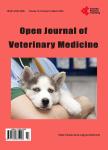Serial Ultrasonographic Measurements to Estimate Age and Viability in <i>Bos indicus</i>Embryos
Serial Ultrasonographic Measurements to Estimate Age and Viability in <i>Bos indicus</i>Embryos作者机构:Departamento de Reproducción Facultad de Medicina Veterinaria y Zootecnia Universidad Nacional Autónoma de México Ciudad Universitaria Ciudad de México México Centro de Enseñ anza Investigación y Extensión en Ganadería Tropical Facultad de Medicina Veterinaria y Zootecnia Universidad Nacional Autónoma de México Tlapacoyan Veracruz México Departamento de Genética y Bioestadística Facultad de Medicina Veterinaria y Zootecnia Universidad Nacional Autónoma de México Ciudad Universitaria Ciudad de México México
出 版 物:《Open Journal of Veterinary Medicine》 (兽医学(英文))
年 卷 期:2019年第9卷第7期
页 面:91-99页
学科分类:1002[医学-临床医学] 100214[医学-肿瘤学] 10[医学]
主 题:Zebu Cattle Embryo Measurement Reproduction Tropics
摘 要:Early pregnancy diagnosis is a very important routine management to identify non-pregnant cows in order to keep an optimum reproductive efficiency both for dairy and beef cows. Ultrasound equipment allows estimating the viability and size of the embryo during early gestation. With the aim of assessing age and viability of Bos indicus embryos between 24 and 35 days of gestation, 55 cows were divided into 4 clusters. These clusters were conformed according to the first day that an echogenic structure was seen inside the embryonic vesicle (Group 1: day 24, Group 2: day 26, Group 3: day 27 and Group 4: day 28). The age of the embryos was estimated from the date of AI. Three progressive serial measurements of their length were made within 2 to 5 days. With a model GEE (Generalized Estimating Equations), the effect of days was evaluated to compare the second measurement with the first one and the former with the third observation. No differences in the size of the embryos were observed between the first evaluation (24 days) and the second (28 days) (P = 0.387). Also, simple linear regression analysis found a positive linear association between the size of the embryo and gestation days (R2 = 0.593) with an average growth of 0.078 cm per day (P = 0.001). In conclusion, the variation between measurements at a given time does not allow estimating with precision the exact day of gestation. Nonetheless, serial measurements are useful to estimate the healthy growth of the embryo from day 26 of gestation.



